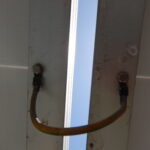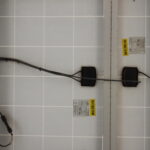Site III.2

Site ID
III.2
Health

COD
2018
Nominal Capacity
57.6 kWp
Average Specific Yield
1403 kWh/kWp
Total Estimated Loss
18.7%
Possible Gain
3% to 5%
CAPEX, OPEX
0.3 ₹/Wp, 0.5 ₹/Wp/a
Expenditure / Energy
N/A
Abstract
The PV plant considers most of the relevant international norms, standards and industry best practices regarding electromechanical installation. However, the PV system is affected by soiling from construction works and residues from the hard water used for cleaning the modules. Furthermore, the module power performance is significantly lower than the expected values. It is recommended to (i) increase cleaning cycles (filtered/soft water), (ii) reinstallation of the temperature sensor and (iii) module power measurements from a larger module sample (and comparison with manufacturer warranties). The estimated production boost expected by the retrofitting actions lies between 3-5%.
Main Findings
The high concentration of dust on top of the modules is likely originated in the construction site next to the system.
Additionally, the water used for cleaning Picture Gallery
the modules leaves a gray residue that intensifies the soiling in the long term.
Although the infrared inspection did not reveal warm cables, the minimum bending radius was partially disregarded when the cables were forced to fit in the structure.
Array Vmpp at 65°C might be lower than the inverter minimum operating voltage (summer), which leads to undervoltage losses.
Impact on Performance
Deviation from South
The azimuth deviation from the optimum (South) represents a 2% loss.
Estimated Loss
≈ 2%
Heavy Soiling
Soiling losses in the selected section at Florida State were calculated in 4.7% on average.
Estimated Loss
≈ 4.7%
Underperformance
The average module under-performance
is ca. 12% (accounting for a 4.7% soiling
losses)
Estimated Loss
≈ 12%
Total Estimated Energy Loss
≈ 18.7%
Proposed Solutions
It is recommended to perform a yearly thermographic inspection to the modules at high irradiations to track the evolution of the cracks.
Manual cleaning shall be implemented and scheduled based on the results of a soiling study that adjusts the cleaning needs to each season.
IV curve measurements from a larger module sample should be performed to validate the current power performance of the modules against the manufacturer warranties.












